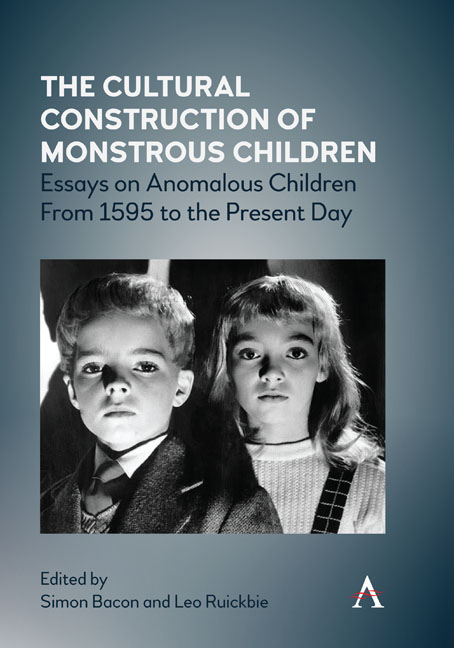 The Cultural Construction of Monstrous Children
The Cultural Construction of Monstrous Children Book contents
- Frontmatter
- Contents
- List of Illustrations
- Acknowledgements
- Introduction
- Part I Historical Case Studies
- Part II Factual Anxiety in Fictional Representations: The Undead Child
- Part III Factual Anxiety in Fictional Representations: The Monstrous Child
- Part IV Cultural Categorization in the Past, Present and Possible Future
- Notes on Contributors
- Index
Introduction
Published online by Cambridge University Press: 20 January 2022
- Frontmatter
- Contents
- List of Illustrations
- Acknowledgements
- Introduction
- Part I Historical Case Studies
- Part II Factual Anxiety in Fictional Representations: The Undead Child
- Part III Factual Anxiety in Fictional Representations: The Monstrous Child
- Part IV Cultural Categorization in the Past, Present and Possible Future
- Notes on Contributors
- Index
Summary
The linkage between children and horror, or ‘horror-full’ children, would seem an almost natural connection to make given its popularity in contemporary horror films and novels. However, the intersection between the two categories has a long history going back beyond the more obvious Gothic reimaginings of the nineteenth century with its underage ghostly terrors revealing that the idea of the ‘little horror’ is seemingly an inherent demarcation within society between adults and those that are viewed as ‘not adults’. Beginning from the sixteenth century, this collection will consider examples of description and interpretation of little horrors from real life and popular culture to show the construction and consolidation of the Western cultural anxiety around the problematic, anomalous child which views it as being monstrous, dangerous and just plain evil.
Horror films, literature, games and graphic novels abound with evil babies, children and adolescents, so much so that Steven Bruhm notes, ‘These days, when you leave the theatre after a fright-movie you can't go home again […] because you’re afraid that your child will kill you.’ While this is about twenty-first century horror film, it rather fittingly captures something of the otherness of children even in an age when the ‘rights’ of the child are, arguably, more defined and children themselves more protected, recognized and listened to than in any other historical period. Somewhat contrarily, it seems that although the child and the associated categories of ‘youth’, ‘adolescent’ and ‘young adult’ are ever more controlled and provided with more scope for agency and self-determination in society, popular culture often sees them constructed as being ‘quintessentially inimical to the adult and adulthood, [signifying] “alien” and “absolute separateness” ‘. This obviously relates to more sensational expressions of youth in popular culture, particularly the horror, Gothic and fantasy genres, but all of which can be seen to be the expression of a deeper cultural anxiety around children, their place in our current historical moment and what kind of future they might embody. But it also points to a certain ambiguity and liminality within the construction of the child as a nexus of many conflicting terms and ideals imposed upon it by adults, from an idyllic (nostalgic) innocence to be cherished and protected to a manipulative, consuming predator to be exploited and broken.
- Type
- Chapter
- Information
- The Cultural Construction of Monstrous ChildrenEssays on Anomalous Children from 1595 to the Present Day, pp. 1 - 20Publisher: Anthem PressPrint publication year: 2020


